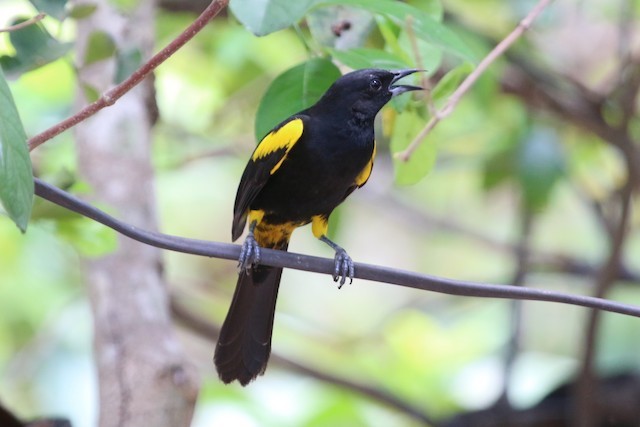Birdfinding.info ⇒ A widespread Cuban endemic that can be found in and around palm trees nearly anywhere on the island, including most of the frequently visited sites: Península de Guanahacabibes National Park, Sierra del Rosario, Ciénaga de Zapata National Park and its surroundings, Cayo Coco, etc. Can be found in Havana as well.
Cuban Oriole
Icterus melanopsis
Endemic to Cuba and its major satellite islands (Isla de la Juventud and most of the northern cays, such as Guillermo, Coco, Romano, and Paredón Grande), where it occurs in all types of woodland that include palms for its nests, including forests, open woodlands, coastal scrub, and settled areas.
Identification
Unlikely to be mistaken for any other species in its range, though similar species inhabit Hispaniola and Puerto Rico.
Adult is mostly black with bright yellow shoulders, leggings, rump, and vent.
Immature is olive overall with a black mask and throat.
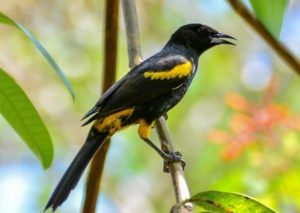
Cuban Oriole. (Playa Larga, Matanzas, Cuba; April 14, 2018.) © Eduardo Ruben Ibarra

Cuban Oriole. (Cayo Paredon Grande, Ciego de Ávila, Cuba; March 17, 2017.) © R. Dennis Ringer

Cuban Oriole, immature. (Bee Hummingbird Garden, Matanzas, Cuba; March 5, 2018.) © Christoph Moning
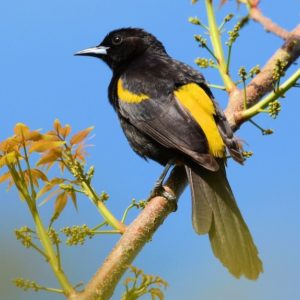
Cuban Oriole. (Santo Tomás, Ciénaga de Zapata National Park, Cuba; March 5, 2018.) © Kenneth Butler
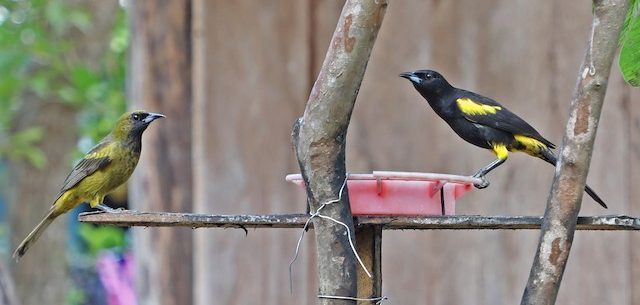
Cuban Oriole, immature and adult. (Santo Tomás, Ciénaga de Zapata National Park, Cuba; April 9, 2018.) © Wendy Hogan
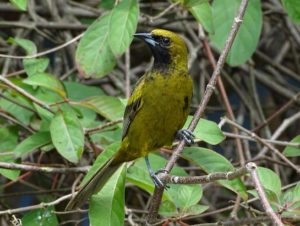
Cuban Oriole, immature. (Bee Hummingbird Garden, Matanzas, Cuba; March 4, 2018.) © Julia Wittmann

Cuban Oriole. (Topes de Collantes National Park, Sancti Spíritus, Cuba; July 15, 2017.) © Erika Gates
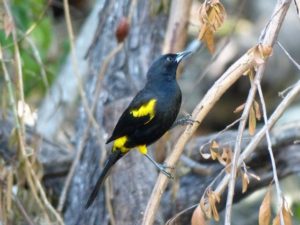
Cuban Oriole. (Cayo Coco, Ciego de Ávila, Cuba; March 11, 2017.) © Warren Dunlop

Cuban Oriole. (February 2009.) © Richard Stern
Voice. Song is a series of widely spaced, down-slurred whistles: Common calls are an abrupt chep! and an inquisitive wheep?:
Notes
Monotypic species.
Formerly considered conspecific with Hispaniolan, Bahama, and Puerto Rican Orioles, collectively known as the Greater Antillean Oriole (Icterus dominicensis). At other times, Greater Antillean was considered conspecific with the Black-cowled Oriole (Icterus prosthemelas) of Central America, collectively known as the Black-cowled Oriole (Icterus dominicensis). The basis for lumping all of these forms together was never strong. The adults are visually distinct and have different songs, and the immature and intermediate plumages are even more visually distinct.
Genetic studies have confirmed that most members of this group are more closely related to other species than they are to one another: the Central American Black-cowled is more closely related to Orchard Oriole; Puerto Rican is more closely related to the three Lesser Antillean orioles (Montserrat, Martinique, and St. Lucia); and Hispaniolan is most closely related to the combined Puerto Rican and Lesser Antillean group. Among the five species formerly lumped together as the “Black-cowled Oriole,” only Cuban and Bahama are a close phyletic pair, although ironically these are the most different from one another visually: Cuban being the blackest and Bahama the yellowest.
References
eBird. 2018. eBird: An online database of bird distribution and abundance. Cornell Lab of Ornithology, Ithaca, N.Y. http://www.ebird.org. (Accessed October 20, 2018.)
Garrido, O.H, and A. Kirkconnell. 2000. Field Guide to the Birds of Cuba. Cornell University Press, Ithaca, N.Y.
Jaramillo, A., and P. Burke. 1999. New World Blackbirds: The Icterids. Princeton University Press, Princeton, N.J.
Navarro, N. 2015. Field Guide to the Endemic Birds of Cuba. Ediciones Nuevos Mundos, St. Augustine, Florida.
Raffaele, H., J. Wiley, O. Garrido, A. Keith, and J. Raffaele. 1998. A Guide to the Birds of the West Indies. Princeton University Press, Princeton, N.J.
